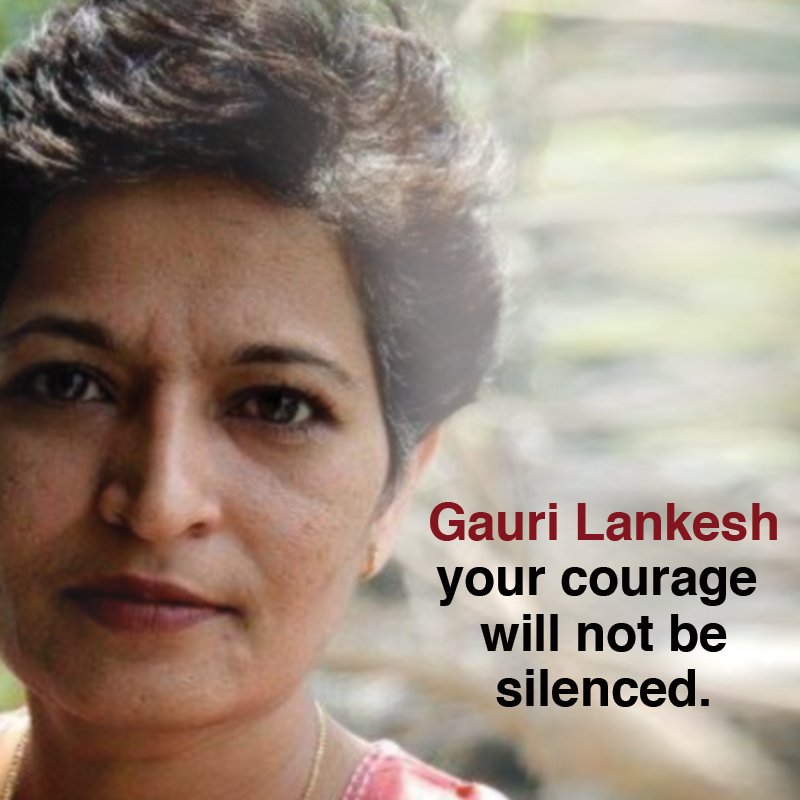The gunning down of journalist Gauri Lankesh is yet another bullet in the heart of those who value free thought in India. Gauri’s murderers remain unknown, some pointing to a Naxal link, others like her own lawyer alleging that ‘Hindu terror units’ took her life.
When it comes to allegations about ‘saffron terror’, not since Nathuram Godse has a Hindutva-inspired assassin openly taken authorship of his act of murder. While Islamist or Maoist extremists generally claim responsibility for their killings, ‘saffron terror’ has been suspected in several cases like recently in the murders of rationalists Dabholkar, Kalburgi and Pansare, arrests have been made but there haven’t been any convictions.
We don’t know who killed Gauri, but we do know who is celebrating. Those on social media jubilant at Gauri’s slaying describe themselves as proud Hindu nationalists, people who Gauri described as her greatest enemy. In fact, Hindu nationalism seeks a new enemy every day.
If Gauri had been alive and expressed her views for example on how India should not deport Rohingya Muslims, she would surely have been screamed at by furious ‘nationalist’ television anchors and branded as a traitor, anti-national jihadist and Naxalite. The fever pitch of TRP-driven accusations often builds to such a crescendo that the individual against whom prime time fingers are pointed ends up becoming public enemy No 1, the equivalent of a criminal who is publicly paraded on TV every night with a metaphorically blackened humiliated face even as a gladiatorial mob on social media howls for her blood.
Violent minds, violent language and violent speech beget violent acts. In an atmosphere where violence is legitimised, endorsed and even seen as a ticket to creating an electoral constituency, the actual act of murder of an ‘anti-national’ only becomes part of a ‘war’. The so-called ‘just war’ against those who insist on the right not to be Hindu nationalists, to be atheist and rationalist, or to criticise superstitions, or to eat beef, to wear mini-skirts, to be homosexual, to attack government policy on Jammu & Kashmir, or to speak in support of JNU students.
The toxic divide between ‘nationalists’ and ‘traitors’ is deeply worrying. Gauri had strong ideas, she spoke out against Hindutva politics, attacked caste discrimination, pushed for Naxals to abandon the gun and argued passionately for sexual liberation of women. In a conservative regional milieu, her voice may have been offensive to some but instead of mounting counterarguments, someone decided her voice had to be forever silenced.
Her killers may have used a gun but don’t we see a symbolic gun pointed at the heads of student activists like Kanhaiya Kumar and Umar Khalid in the manner they are publicly vilified? Doesn’t the gun loom large when hit lists are circulated, naming women journalists and activists as next targets after Gauri? The cult of violence is breeding faster than the aedes aegypti mosquito and infecting many with the fever of blood lust against those they disagree with.
Particularly violent language is directed at the media. Ministers can label media as ‘presstitutes’, a BJP MP can call for a noted author to be tied to a jeep, noxious foul-mouthed abusers get strength and even legitimacy from the fact that they are ‘followed’ by our top political leadership. Journalists have been threatened, intimidated and murdered before, especially in far flung areas where telling the truth means risking all. But today, are attacks against journalists being endorsed by the ruling party when it issues only perfunctory condemnations of Gauri’s murder, instead of a ringing declaration that attacks on media persons will not be tolerated?
When the government itself takes pride in an anti-media stance, when certain journalists are boycotted by ruling party ministers, when critical journalists are censored and labelled ‘news traders’ by the political leadership, when lawyers who beat up female reporters are not censured, then is the government itself creating an environment encouraging violence against the press?
Too much religious ideology in politics inevitably creates violence in society. Those rulers who practice ‘soft Islamism’ or ‘soft Hindutva’ open the gate for more radical extremists to gain legitimacy. The divide between Hindus and Muslims is being catastrophically sharpened today, with every new issue like azaan, or beef ban or Vande Mataram or even the so-called competing claims of shamshans and kabristans becoming a tacit political signal for violent goons to take over the argument and physically attack the targets of their rage.
‘Shout don’t shoot’ is supposed to be the mantra of democracy, but when democracy becomes entwined with irrational religious ideology then shout becomes tacit permission to shoot, all norms of parliamentary democracy brushed aside by those empowered by blind faith.
In a recent interaction former RBI governor Raghuram Rajan said that open-mindedness is a crucial pre-requisite for high growth economies that rely on the service sector. The manner in which Gauri’s death is being legitimised as just punishment for traitors shows that far from open-mindedness, those who dare to think differently are seen as natural targets for assassination.
If we as a society don’t speak up now, there will be more deaths, and each ‘anti-national’ murder will be celebrated more noisily than ever. As TV anchors unleash deadly calls to metaphorically eliminate the enemy, the legitimacy of violence will become widespread. That’s why, strict exemplary action must be taken against those who celebrate violence because they are just as culpable as Gauri’s killers.
https://blogs.timesofindia.indiatimes.com/bloody-mary/the-right-to-murder-violence-against-anyone-dubbed-anti-national-is-being-legitimised-and-endorsed/

September 16, 2017 at 9:21 pm
The celebrations after gruesome murder of Gauri Lankesh by the hindutva forces indicate legitimising violence. This is bad for a nation that boasts itself as democracy